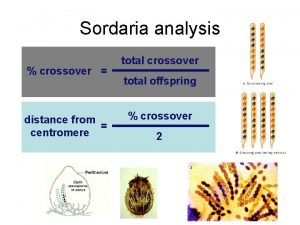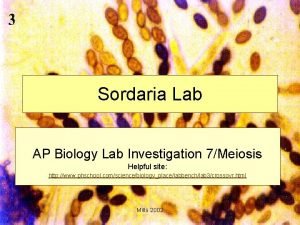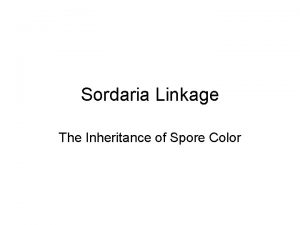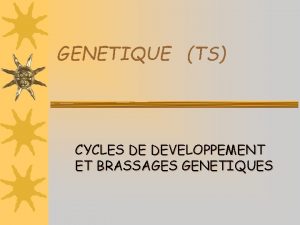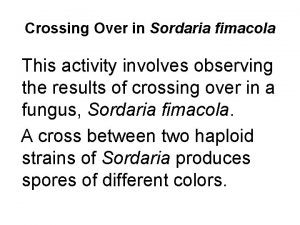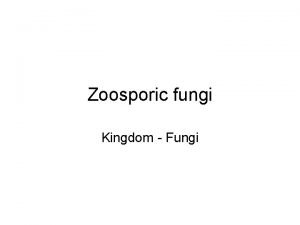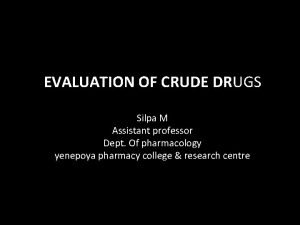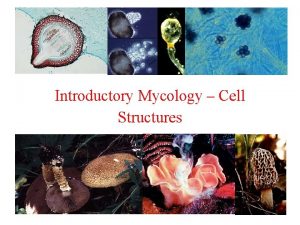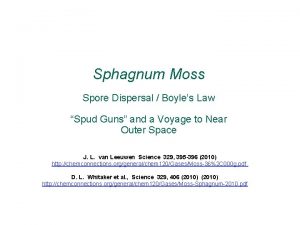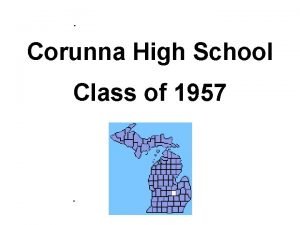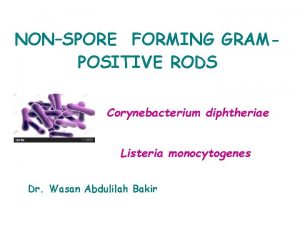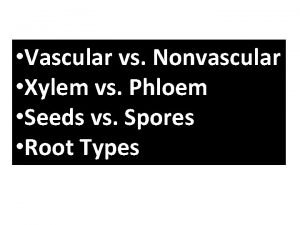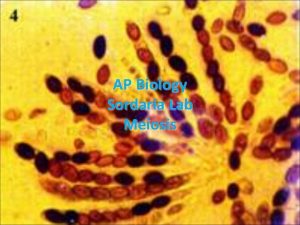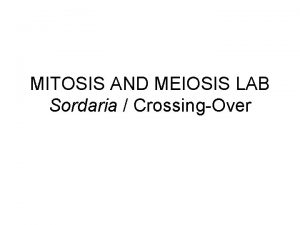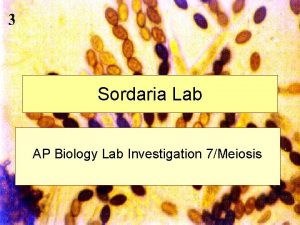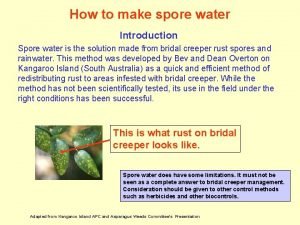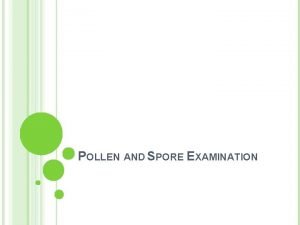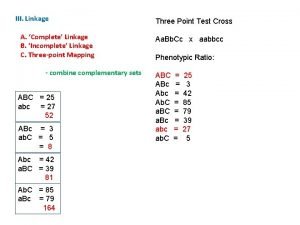Sordaria Linkage The Inheritance of Spore Color Sordaria


















- Slides: 18

Sordaria Linkage The Inheritance of Spore Color

Sordaria Life Cycle

I. Spore color • A. Natural spore color is black • B. Produced by the action of two genes • C. The alleles are represented as: 1. t+ for the wild type 2. t for the mutant (which by itself produces tan 3. g+ for the wild type 4. g for the mutant (which by itself produces gray. 5. if both mutants are present-the phenotype of the ascus is clear

D. Possible genotypes and resultant phenotypes • • 1. recall that fungi normally exist in the haploid state 2. therefore no such thing as dominance and recessiveness 3. g+t+ produces black 4. gt+ produces a gray spores 5. g+t produces tan spores 6. gt produces clear spores 7. you do not know if the genes collaborating for spore color are on the same or different chromosomes

II. Tan X Black A determination of cross over frequency • A. tg+ X t+g+ tan X black • B. Since the second allele is the same in both we can ignore the “g” allele for this exercise • C. We will be trying to measure the percent crossing over between the “t” gene and its centromere

D. Normally • 1. notice parental types are haploid • 2. opposite mating hypha would undergo plasmogamy to produce the dikaryotic stage • 3. karyogamy follows within the asci followed by meiosis I and II • 4. in this example crossing over did not occur • 5. no crossing over is indicated by four spores of one type followed by four spores of the second

E. If crossing over happens, spore arrangement in the asci will be different than 4: 4 • 1. Events are the same initially as the slide before • 2. Now crossing over occurs at prophase I • 3. Sister chromatids of the two chromosomes are now modified • 4. Will result in a different spore pattern laid down in the asci

5. Are any other spore patterns possible that would indicate that crossing over has occurred? • a. How would you get a “ 2: 4: 2” pattern?

6. • • a. b. c. d. To calculate the percent crossing over make a smash of the sordaria count parental asci recombinant asci % crossover =


Typical Results for Tan X Black

Black X Tan

III. Linkage • A. Recall that spore color is due to two genes • B. g+t+ gives you black • gt+ produces a gray spores g+t produces tan spores gt produces clear spores C. Are the genes for spore color on the same chromosome or on different chromosomes D. The cross gray X tan can give us the answer

E. Two possible alignments of the chromosomes at the metaphase I plate if unlinked • • • 1. What alleles will be traveling together in the products of meiosis in each case? 2. What spore colors result? 3. What will be the arrangement of spores in the asci? 4. The arrangement at the left will result in the parental pattern. 5. The arrangement at the right=recombinant 6. If the genes are unlinked we will expect these two classes of asci to be produced in equal numbers

F. If the genes are linked on the same chromosome, different results will occur • 1. Notice that the genes travel to the next generation together • 2. Most often you would expect to find the tan and gray ascospores in a 4: 4 pattern • 3. Recall that this is called the parental condition • 4. How could you get the CCCCBBBB pattern of the previous slide?

F. Linked explanation continued • 5. The t and g alleles must be recombined on one chromosome • 6. The t+ and g+ alleles must also travel together • 7. The only way for this to happen is with a double cross-over event. • 8. Recall that the recombinant ascus has CCCCBBBB seen in the ascus • 9. Will this event be relatively rare? • 10. What do you expect to find in the counting of the asci from this cross if the genes are linked?

IV. Tetratypes • A. Other combinations of spore phenotypes are possible in the asci in the tan X gray cross • B. They don’t shed any evidence whether the genes are linked or not. • C. They do not provide evidence of linkage and the ability to do some thinking about meiosis in Sordaria. • D. Examine the case at the right • E. Just because the genes are shown as being linked here, does not mean that they are in reality

F. Here is an example of a tetratype without having linkage come into play. • 1. You should be able to explain other spore patterns following the type of reasoning seen at the right. • 2. Remember when you are counting the tan X gray cross that you are really interested in the relative numbers of • TTTTGGGG vs CCCCBBBB • Parental vs. Recombinant • The tetratypes are interesting but they don’t answer the question of linkage
 Linkage editors
Linkage editors Crossover distance
Crossover distance Sordaria lab ap biology answers
Sordaria lab ap biology answers Sordaria sp.
Sordaria sp. Schéma brassage interchromosomique et intrachromosomique
Schéma brassage interchromosomique et intrachromosomique Sordaria crossing over
Sordaria crossing over Zoosporic fungi definition
Zoosporic fungi definition Evaluation of crude drugs
Evaluation of crude drugs Seed vs spore
Seed vs spore Fungi cell wall
Fungi cell wall Spore fps cap
Spore fps cap The spore dsrip
The spore dsrip Spore
Spore Corynebacterium diphtheriae spore forming
Corynebacterium diphtheriae spore forming Threadlike fungi
Threadlike fungi Spore formation reproduction
Spore formation reproduction Spore formation reproduction
Spore formation reproduction Xylem vs phloem
Xylem vs phloem Lycopodium spore method formula
Lycopodium spore method formula

